Contents
| |||||
| Decades: | |||||
|---|---|---|---|---|---|
| See also: | Other events of 1588 List of years in Spain | ||||
Events in the year 1588 in Spain .
| |||||
| Decades: | |||||
|---|---|---|---|---|---|
| See also: | Other events of 1588 List of years in Spain | ||||
Events in the year 1588 in Spain .

1588 (MDLXXXVIII) was a leap year starting on Friday of the Gregorian calendar and a leap year starting on Monday of the Julian calendar, the 1588th year of the Common Era (CE) and Anno Domini (AD) designations, the 588th year of the 2nd millennium, the 88th year of the 16th century, and the 9th year of the 1580s decade. As of the start of 1588, the Gregorian calendar was 10 days ahead of the Julian calendar, which remained in localized use until 1923.

A fire ship or fireship is a large wooden vessel set on fire to be used against enemy ships during a ramming attack or similar maneuver. Fireships were used to great effect against wooden ships throughout naval military history up until the advent of metal-hulled ships; they could also serve a considerable function in shock and awe strategies to harm the morale of enemy crews. Ships used for fireship tactics were typically purpose-built or retrofitted from surplus or obsolete vessels, either of which could be filled with gunpowder or other combustibles before a battle, but could also be improvised from warships in active combat purposefully set on fire during engagements, such as if a vessel expended its munitions or had some other reason to be abandoned in battle.
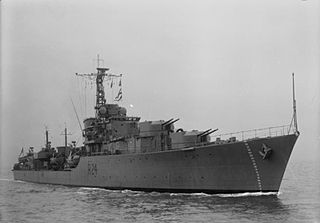
HMS Gravelines was a Battle-class destroyer of the Royal Navy. She was named after the Battle of Gravelines, which took place in 1588, resulting in the English Navy defeating the Spanish Armada. Gravelines was built by Cammell Laird of Birkenhead. She was laid down on 10 August 1943, launched on 30 November 1944 and completed on 14 June 1946.
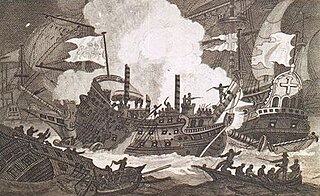
Revenge was an English race-built galleon of 46 guns, built in 1577 and captured by the Spanish in 1591, sinking soon afterwards. She was the first of 13 English and Royal Navy ships to bear the name.

The Anglo-Spanish War (1585–1604) was an intermittent conflict between the Habsburg Kingdom of Spain and the Kingdom of England that was never formally declared. It began with England's military expedition in 1585 to what was then the Spanish Netherlands under the command of Robert Dudley, Earl of Leicester, in support of the Dutch rebellion against Spanish Habsburg rule.

The Antelope was a ship of the English Tudor navy, launched in 1546. She was rebuilt three times, in 1558, 1581 and 1618. She thus served in various forms from the time of King Henry VIII to the English Civil War. She is mostly remembered for being a part of the fleet that defeated the Spanish Armada.

The Spanish Armada was a Spanish fleet that sailed from Lisbon in late May 1588, commanded by Alonso de Guzmán, Duke of Medina Sidonia, an aristocrat without previous naval experience appointed by Philip II of Spain. His orders were to sail up the English Channel, join with the Duke of Parma in Flanders, and escort an invasion force that would land in England and overthrow Elizabeth I. Its purpose was to reinstate Catholicism in England, end support for the Dutch Republic, and prevent attacks by English and Dutch privateers against Spanish interests in the Americas.
The Spanish Armada in Ireland refers to the landfall made upon the coast of Ireland in September 1588 of a large portion of the 130-strong fleet sent by Philip II to invade England.
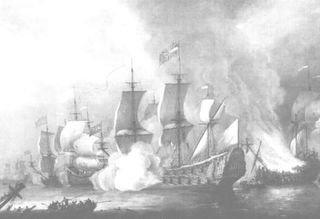
The Battle of Bantry Bay was a naval engagement fought on 11 May 1689, a week before the declaration of the Nine Years' War. The English fleet was commanded by Admiral Arthur Herbert, created Earl of Torrington after the Battle; the French fleet by François Louis de Rousselet, Marquis de Châteaurenault. Apart from the inshore operations at La Rochelle in 1627–28, the Battle of Bantry Bay was the first time English and French navies had met in fleet action since 1545.

São Martinho or San Martín, built as a Portuguese Navy galleon, became the flagship of the Duke of Medina Sedonia, the commander-in-chief of the Spanish Armada.
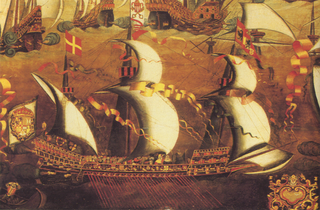
A galleass was a warship that combined the sails and armament of a galleon with the maneuverability of the oared galley. While never quite matching up to the full expectations for its design, the galleass nevertheless remained in use during the 16th and 17th centuries.
Events from the 1580s in England.
The Armada of 1779 was a combined Franco-Spanish naval enterprise intended to divert British military assets, primarily of the Royal Navy, from other war theatres by invading the Kingdom of Great Britain during the American Revolutionary War. This action was a part of the wider Anglo-French War (1778–1783). The proposed plan was to seize the Isle of Wight and then capture the British naval base of Portsmouth. Ultimately, no fleet battles were fought in the Channel and the Franco-Spanish invasion never materialized. This threat to Great Britain prompted comparisons to the earlier Spanish Armada of 1588.

The Battle of Blaye of 1593, also known as the Battle of Bec d'Ambès or Battle of the Gironde Estuary, was a naval Spanish victory that took place on 18 April 1593 off Blaye and Bec d'Ambès, Gironde Estuary, France, during the seven-month siege of Blaye between the French-Protestant forces of Henry of Navarre and the French-Catholic garrison of the city led by Governor Jean-Paul d'Esparbès de Lussan d'Aubeterre, in the context of the Brittany Campaign during the French Wars of Religion and the Anglo-Spanish War (1585–1604).

The Sea Dogs were a group of English privateers and explorers authorised by Queen Elizabeth I to raid England's enemies, whether they were formally at war with them or not. Active from 1560 until Elizabeth's death in 1603, the Sea Dogs primarily attacked Spanish targets both on land and at sea, particularly during the Anglo-Spanish War. Members of the Sea Dogs, including Sir John Hawkins and Sir Francis Drake, also engaged in illicit slave trading with Spanish colonies in the Americas.
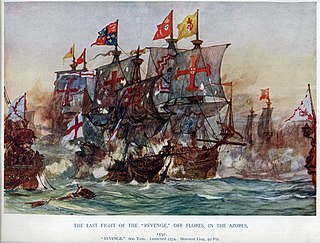
The Battle of Flores was a naval engagement during the Brittany Campaign of the Anglo-Spanish War of 1585 fought off the Island of Flores between an English fleet of 22 ships under Lord Thomas Howard and a Spanish fleet of 55 ships under Alonso de Bazán. Sent to the Azores to capture the annual Spanish treasure convoy, when a stronger Spanish fleet appeared off Flores, Howard ordered his ships to flee to the north, saving all of them except the galleon Revenge commanded by Admiral Sir Richard Grenville.
Don Martín de Bertendona was an important officer of the Spanish Navy under Philip II and Philip III. He participated in the Spanish Armada, and had a role in the capture of the iconic English galleon Revenge in 1591.

The Battle of the Narrow Seas, also known as the Battle of the Goodwin Sands or Battle of the Dover Straits was a naval engagement that took place on 3–4 October 1602 during the Anglo-Spanish War of 1585 and part of the Dutch Revolt. An English fleet under Sir Robert Mansell intercepted and attacked six Spanish galleys under the command of Federico Spinola in the Dover Straits. The battle was fought initially off the coast of England and finally off the Spanish Netherlands. The English were soon joined by a Dutch fleet under Jan Adriaanszoon Cant, and they completed the destruction.

The Battle of the Gulf of Almería, also known as the Battle of Almería Bay or the Battle of Cape of Palos, was a naval Spanish victory that took place in late August, 1591, off Almería, near the Cape Palos, during the Eighty Years' War and the Anglo–Spanish War (1585–1604). The battle occurred when the Spanish fleet of the Adelantado of Castile, Don Martín de Padilla y Manrique, Count of Santa Gadea, sighted an Anglo-Dutch fleet in the waters of Almería, on the southern coast of Spain. The Spanish fleet, led by Martín de Padilla, attacked with such fury the Anglo-Dutch fleet who managed to undo their training, achieved a great success. About 20 Dutch ships and 3 English ships were captured by the Spaniards, and some ships of the rest of the Anglo-Dutch fleet were seriously damaged. On the other hand, the Spanish losses were minimal.

The 3rd Spanish Armada, also known as the Spanish Armada of 1597, was involved in a major naval event that took place between 18 October and 15 November 1597 as part of the Anglo–Spanish War. The attack of the armada, which was the third attempt by Spain to invade or raid the British Isles during the war, was ordered by King Philip II of Spain in revenge for the English attack on Cadiz following the failure of the 2nd Spanish Armada the previous year due to a storm. The Armada was executed by the Adelantado Martín de Padilla, who was hoping to intercept and destroy the English fleet under Robert Devereux the 2nd Earl of Essex as it returned from the failed Azores expedition. When this was achieved, the Armada would go on to capture either the important port of Falmouth or Milford Haven and use those places as a base for invasion.